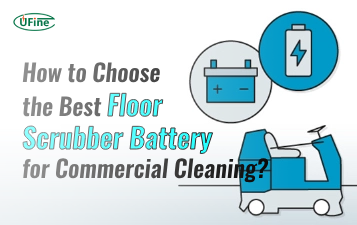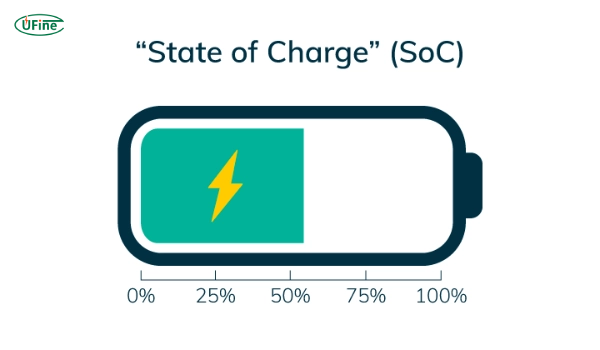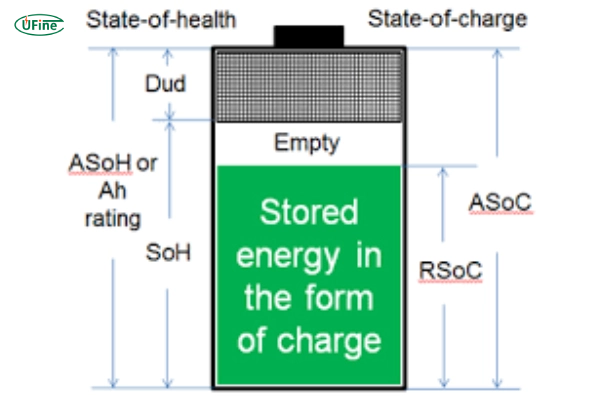What are battery SoC and SoH? The State of Charge (SoC) indicates current energy levels like a fuel gauge, while State of Health (SoH) measures battery degradation over time. Understanding these metrics is critical for optimizing performance, preventing failures, and maximizing battery lifespan across devices from smartphones to electric vehicles.
You know your battery’s State of Charge (SoC) and State of Health (SoH). These help you keep your battery working well and lasting longer. This article will explain their relationship and best practices for maintaining them. This will help you get the most out of your batteries.
Part 1. Understanding battery state of charge (SoC)
Battery State of Charge (SoC)
The Battery State of Charge (SoC) is the ratio of the current charge in the battery to its maximum possible charge. It is like a fuel gauge for batteries. SoC indicates how much charge remains in the battery and is usually displayed as a percentage. For example, 100% means the battery holds a full charge, and 0% is empty. SoC can also be shown using voltage levels; a higher voltage indicates a higher SoC.
Methods of Measuring SoC
1. Coulomb Counting
Coulomb counting is a common way to measure SoC. This method counts the electric charge in and out of the battery. It works by measuring the current flow and keeping track of the time. This gives an accurate measure of the charge used and the charge left.
Advantages:
- It is accurate when the initial SoC is known.
- Useful for tracking change over time.
Limitations:
- Errors can build up over time if not corrected.
- An accurate initial SoC is needed to be effective.
- Sensitive to measurement errors and noise.
2. Voltage Method
The voltage method measures the battery’s voltage to estimate the SoC. Different voltage levels correspond to different SoC values. This method is simple and easy to use.
Factors affecting accuracy:
- Battery type: Different batteries have different voltage characteristics.
- Temperature: Temperature changes can affect voltage readings.
- Load: The current load on the battery can change the voltage.
Advantages:
- Simple and quick.
- No need for complex equipment.
Limitations:
- It is less accurate than other methods.
- It is affected by many external factors like temperature and load.
3. Impedance Spectroscopy
Impedance spectroscopy measures the battery’s internal resistance to estimate SoC. This method sends a small alternating current (AC) through the battery and measures the voltage response. It helps to understand the battery’s internal properties.
Benefits:
- Provides detailed information about the battery’s condition.
- It can be very accurate when done correctly.
Drawbacks:
- Requires specialized equipment.
- More complex and time-consuming.
- It is not commonly used for everyday applications due to its complexity.
Importance of SoC Monitoring
Role of SoC in Preventing Overcharging and Deep Discharging
- Monitoring SoC helps avoid overcharging, which can damage the battery.
- It also prevents deep discharging, which can shorten the battery life.
- Keeping SoC in the correct range makes the battery last longer.
Impact on Battery Performance and Lifespan
- Correct SoC ensures the battery works well.
- It makes the battery reliable.
- It helps the battery to perform at its best.
Applications Where Accurate SoC Monitoring is Critical
- Electric Vehicles: They need precise SoC to avoid running out of power.
- Renewable Energy Storage: Accurate SoC helps use solar and wind energy efficiently.
- Portable Devices: Phones and laptops need good SoC to keep running throughout the day.
How to Measure Battery State of Charge
- Step 1: Choose measurement method – Use voltage testing for quick estimates or Coulomb counting for precision measurements
- Step 2: Calibrate equipment – Ensure multimeters or battery testers are properly calibrated
- Step 3: Monitor under load – Measure voltage during discharge cycles for real-world usage data
Part 2. Understanding battery state of health (SoH)
Battery State of Health
Battery State of Health (SoH) tells how good a battery is. It shows how much life the battery has left. SoH compares the battery’s current condition to when it was new. If a battery has 80% SoH, it can only hold 80% of the charge it could when it was new. This helps you know if the battery needs replacing soon.
Methods of Assessing SOH
1. Capacity Testing
Process of Capacity Testing:
- Fully charge the battery.
- Discharge it while measuring how much energy it gives out.
- Compare this to the battery’s original capacity.
Interpretation of Capacity Test Results:
- If a battery gives out much less energy than it used to, its SoH could be better.
- For example, if a 1000mAh battery only gives 800mAh, it has 80% of its original capacity.
2. Internal Resistance Measurement
How Internal Resistance Reflects the Health of the Battery:
- Low resistance means the battery can deliver power efficiently.
- High resistance means the battery struggles to deliver power.
- As batteries age, their internal resistance goes up.
Techniques for Measuring Internal Resistance:
- Use a specialized meter to measure voltage and current.
- Calculate resistance using Ohm’s Law (Resistance = Voltage / Current).
- Compare the result to the battery’s specs.
3. Self-discharge Rate
Explanation of Self-discharge Rate as an SOH Indicator:
- Self-discharge is how fast a battery loses charge when not in use.
- A high self-discharge rate means the battery is not healthy.
- Healthy batteries keep their charge for a long time.
Methods to Measure and Interpret Self-discharge Rates:
- Fully charge the battery and let it sit for a week.
- Measure how much charge is left.
- If the battery loses a lot of charge quickly, its SoH is poor.
Factors Affecting SoH
Age of the Battery
- Batteries degrade over time, even without use.
- Older batteries hold less charge and perform worse.
Number of Charge-Discharge Cycles
- Each charge and discharge cycle wears the battery down.
- More cycles lead to a shorter battery lifespan.
Operating Temperature and Environmental Conditions
- Extreme heat or cold can damage batteries.
- Stable, moderate temperatures are best for battery health.
Storage Conditions and Maintenance Practices
- Proper storage and regular maintenance extend battery life.
- Keep batteries clean, dry, and at optimal charge levels.
How to Check Battery Health
- Perform full discharge test to measure actual capacity against original specifications
- Use professional diagnostic tools like battery analyzers for internal resistance measurement
- Track self-discharge rates over 48 hours to identify abnormal energy loss
Part 3. Battery SoC vs SoH: Key differences explained
| State of Charge (SoC) | State of Health (SoH) | |
|---|---|---|
| Measures | Current charge level | Overall battery capacity |
| Measurement Unit | Percentage (0-100%) | Percentage (0-100%) |
| Testing Method | Voltage/Coulomb counting | Capacity/Resistance tests |
Part 4. Relationship between SoC and SoH
How SoC Influences SoH
Impact of Overcharging and Deep Discharging:
- Overcharging a battery makes it too hot and damages it over time. Deep discharging stresses the battery, making it wear out faster.
Optimal SoC Range and Battery Life:
- Keeping the battery charged between 20% and 80% helps it last longer. It reduces strain on the battery and keeps it working well for a longer time.
How SoH Affects SoC Accuracy
Battery Aging and SoC Accuracy:
- As batteries age, they cannot hold as much charge. This affects how accurately we can tell how much charge is left (SoC). Older batteries might show wrong readings or lose charge quickly.
Adjusting SoC Estimates for Aging Batteries:
- Innovative systems adjust how they measure SoC as batteries age. They use battery resistance and past use to give better readings, even as the battery ages.
Part 5. Real-world applications of SoC and SoH management
Electric Vehicles (EVs)
Maintaining 20-80% SoC range extends EV battery lifespan by up to 60%. Regular SoH checks every 3,000 miles prevent unexpected capacity drops.
Solar Energy Storage
Deep cycle batteries in solar systems require weekly SoC monitoring to balance energy input/output. Annual SoH testing ensures 90%+ capacity retention for 5+ years.
Medical Equipment
Critical devices like portable oxygen concentrators need daily SoC checks and monthly SoH verification to maintain uninterrupted operation.
Part 6. Best practices for maintaining SoC and SoH
Regular Monitoring
Regularly check your battery’s SoC and SoH. Use tools like battery management systems (BMS) to get accurate readings. This helps you keep track of the battery’s condition and make necessary adjustments.
Optimal Charging Practices
Avoid overcharging your battery. Once it reaches 80% charge, try to stop charging. Similarly, don’t let the battery go below 20%. These practices prevent stress on the battery and extend its life.
Temperature Management
Keep your battery at a stable temperature. Avoid exposing it to extreme heat or cold. If possible, use temperature control systems. This helps maintain both SoC and SoH.
Proper Storage
Store your battery in a cool, dry place. If you don’t use it for a while, keep it at about 50% charge. This prevents degradation and keeps the battery healthy.
Regular Maintenance
Perform regular maintenance on your battery. Clean the terminals and check for any signs of wear or damage. Replace the battery if it shows a significant decline in SoH. Regular maintenance ensures the battery remains in good condition and performs well.
Part 7. FAQs about battery SoC and SoH
How often should I check my battery’s State of Health?
Test lithium-ion batteries every 3 months and lead-acid batteries every 6 months. High-usage devices like EVs require monthly checks.
Can I improve a battery’s State of Health after degradation?
While physical degradation is irreversible, calibration cycles and proper storage at 50% charge can recover up to 5% capacity in mildly degraded batteries.
What’s the ideal SoC for long-term battery storage?
Maintain 40–60% SoC during storage. This range minimizes chemical stress while preventing deep discharge damage.
Do battery health apps provide accurate SoH readings?
Consumer apps offer approximate estimates (±15% accuracy). For precise measurements, use professional battery analyzers with impedance spectroscopy.
Related Tags:
More Articles

How to Choose the Best Floor Scrubber Battery for Commercial Cleaning?
Selecting the ideal floor scrubber battery ensures a long runtime, rapid charging, and minimal maintenance for efficient commercial cleaning operations.
Battery for Blower vs Battery for Leaf Vacuum: Which One Should You Choose?
Battery for blower vs leaf vacuum—learn the key differences in power, fit, and runtime to choose the right battery for your outdoor tool needs.
How to Choose the Right Battery for Blower?
Choosing the right blower battery? Consider voltage, capacity, chemistry & usage. This guide helps match the best battery for peak performance.
How to Choose the Best Insulated Battery Box for Lithium Batteries?
Choosing the Best Insulated Battery Box for Lithium Batteries? Discover key factors such as size, material, and safety for optimal protection and performance.
7 Critical Elements on a Lithium Battery Shipping Label
What must be on a lithium battery shipping label? Learn 7 key elements to ensure safety, legal compliance, and correct handling across all transport modes.






